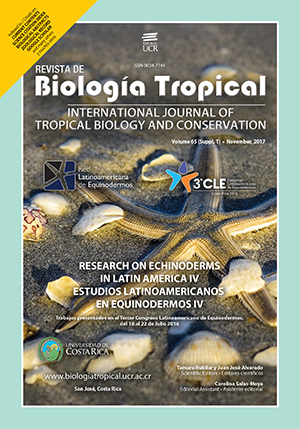Abstract
Between 1978 and 1982 the ruins of the Templo Mayor of Tenochtitlan were exhumed a few meters northward from the central plaza (Zócalo) of Mexico City. The temple was the center of the Mexica’s ritual life and one of the most famous ceremonial buildings of its time (15th and 16th centuries). More than 200 offerings have been recovered in the temple and surrounding buildings. We identified vestiges of 14 species of echinoderms (mostly as disarticulated plates). These include six species of sea stars (Luidia superba, Astropecten regalis, Astropecten duplicatus, Phataria unifascialis, Nidorellia armata, Pentaceraster cumingi), one ophiuroid species (Ophiothrix rudis), two species of sea urchins (Eucidaris thouarsii, Echinometra vanbrunti), four species of sand dollars (Mellita quinquiesperforata, Mellita notabilis, Encope laevis, Clypeaster speciosus) and one species of sea biscuit (Meoma ventricosa grandis). They date back to the reigns of kings Axayacatl (AD 1469-1481), Tizoc (AD 1481-1486), Ahuitzotl (AD 1486-1502), and Motecuhzoma II (AD 1502-1520). Apparently the presence of echinoderms in the offerings is related to the realm of Tlaloc (god of rain and earth). It is believed this organisms, like other marine animals, were used by the priests, like other marine animals, to represent the aquatic underworld of Mesoamerican world-view. Rev. Biol. Trop. 65(Suppl. 1): S168-S179. Epub 2017 November 01.
References
Echinoderm (Echinodermata) diversity in the Pacific coast of Central America. Marine Biodiversity, 40(1), 45-56.
Clark, H. L. (1948). A report of the echini of the warmer eastern Pacific, based on the collections of the “Velero III”. Allan Hancock Pacific Expedition, 8(5): 225-351.
Clark, A. M., & Downey, M. E. (1992). Starfishes of the Atlantic. London, UK. Chapman & Hall.
González López, A., López Luján, L., Martín-Cao Martínez, C., Solís-Marín, F. A. & Zúñiga-Arellano, B. (2011). Una estrella de mar encontrada en la ofrenda dedicatoria al monolito de Tlaltecuhtli, Templo Mayor de Tenochtitlan. Arqueología Mexicana, 19(112), 15-16.
Hassig, R. (1988). Aztec Warfare: Imperial Expansion and Political Control. Norman: University of Oklahoma Press.
Kalof, L. (2012). Oxford handbook of animal studies. New York: NY. Oxford University Press.
Kerr, T. J. V., & Twitchett, R. J. (2004). Experimental decay and disarticulation of Ophiura texturata: implications for the fossil record of ophiuroids. In Balkema Press (Ed.), Proceedings of the 11th International Echinoderm Conference (pp. 439-446). München, Germany: Heinzeller, T. & Nebelsick, J. H.
López Austin, A. & López Luján, L. (2009). Monte Sagrado/Templo Mayor: El cerro y la pirámide en la tradición religiosa mesoamericana. Mexico City: INAH/UNAM.
López Austin, A. & López Luján, L. (2017). State Ritual and Religion in the Sacred Precinct of Tenochtitlan. In D. L. Nichols & E. Rodríguez-Alegría (Eds.), The Oxford Handbook of the Aztecs (pp. 605-621). New York: Oxford University Press.
López Luján, L. (2001). Tenochtitlán: Ceremonial Centers. In S. T. Evans & D. L. Webster (Eds.), Archaeology of Ancient Mexico and Central America: An Encyclopedia (pp. 712-717). New York, NY: Garland Publishing.
López Luján, L. (2005). The offerings of the Templo Mayor of Tenochtitlan. Albuquerque, NM: UNM Press.
López Luján L., Chávez Balderas X., Zúñiga-Arellano B., Aguirre Molina A. & Valentín Maldonado N. (2014). Entering the Underworld: Animal Offerings at the Foot of the Great Temple of Tenochtitlan. In B. S. Arbuckle & S. A. McCarty (Eds.), Animals and Inequality in the Ancient World (pp. 33-61). Boulder, CO: University Press of Colorado.
Pérez-Ruzafa, A., Alvarado, J. J., Solís-Marín, F. A., Hernández, J. C., Morata, A., Marcos, C., ... & Barraza, E. (2013). Latin America echinoderm biodiversity and biogeography: Patterns and affinities. In J. J. Alvarado & F. A. Solís-Marín (Eds.), Echinoderm research and diversity in Latin America (pp. 511-542). Berlin Heidelberg: Springer.
Santoyo, E., Ovando, S. E., Mooser, F., & León, E. (2005). Síntesis geotécnica de la cuenca del Valle de México. Mexico City: TGC Geotecnia.
Solís-Marín, F. A., Honey-Escandón, M. B., Herrero-Pérezrul, M. D., Benitez-Villalobos, F., Díaz-Martínez, J. P., Buitrón-Sánchez, B. E., ... & Durán-González, A. (2013). The echinoderms of Mexico: biodiversity, distribution and current state of knowledge. In J. J. Alvarado & F. A. Solís-Marín (Eds.), Echinoderm research and diversity in Latin America (pp.11-65). Berlin Heidelberg: Springer.
Solís-Marín, F. A., Laguarda-Figueras, A., Martínez-Melo, A., Celaya Hernandez, E. V., Velasquez-Castro, N., Barrera-Rivera, J. A., ... & Valentín-Maldonado, N. (2010). Echinoderm remains in the offerings of the Great Temple of the Aztecs. In Echinoderms: Durham. Proceedings of the 12th International Echinoderm Conference (pp. 77-79). Leiden: Balkema.
Thuy, B., & Stöhr, S. (2016). A New Morphological Phylogeny of the Ophiuroidea (Echinodermata) Accords with Molecular Evidence and Renders Microfossils Accessible for Cladistics. PloS one, 11(5), e0156140.
Ziesenhenne, F. C. (1937). The Templeton Crocker Expedition. X. Echinoderms from the West Coast of Lower California, the Gulf of California and Clarion Island. Zoologica, 22(15): 209-239.
Zúñiga-Arellano, B., López Luján, L., Caballero-Ochoa, Solís-Marín, A. F., Martín Cao Romero, C., & Hernández Díaz, Y. Q. (n.d.). Estrellas de mar en las ofrendas del Templo Mayor de Tenochtitlan. In L. López Luján & X. Chávez Balderas (Eds.), Al pie del Templo Mayor de Tenochtitlan: ensayos en honor a Eduardo Matos Moctezuma. Mexico City: El Colegio Nacional, in press.
##plugins.facebook.comentarios##

This work is licensed under a Creative Commons Attribution 4.0 International License.
Copyright (c) 2017 Revista de Biología Tropical






